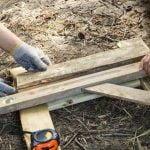Woodworking is a rewarding hobby that allows individuals to create beautiful and functional pieces out of wood. However, for those living in an apartment, the lack of space and noise restrictions can make pursuing this craft seem challenging.
In this article, we will explore how to do woodworking when you live in an apartment and provide tips on selecting the right tools, setting up a small woodworking space, choosing the right materials, controlling noise and dust, ensuring safety, organizing supplies, and embarking on creative projects.
Living in an apartment does not have to mean giving up on your passion for woodworking. With careful planning and consideration for your living situation, it is possible to indulge in this craft while being respectful of your neighbors and abiding by apartment regulations.
In the following sections, we will delve into the specifics of apartment woodworking, from selecting the appropriate tools and setting up a workspace that fits within the confines of an apartment, to controlling noise and dust, ensuring safety, organizing supplies to undertaking creative projects despite limited space constraints. Whether you are a seasoned woodworker or just starting out in this craft, this article will provide valuable insights and practical advice for pursuing your woodworking passion in an apartment setting.
Selecting the Right Tools for Apartment Woodworking
When it comes to woodworking in an apartment, selecting the right tools is crucial. With limited space, it’s important to choose tools that are versatile, compact, and suitable for indoor use. Here are some essential tools to consider for apartment woodworking:
Hand Tools
Hand tools are essential for apartment woodworking due to their compact size and minimal noise production. Consider investing in a quality set of chisels, a hand plane, a Japanese pull saw, a coping saw, and a set of carving tools. These hand tools can help you create intricate details and precise cuts without taking up too much space in your apartment.
Portable Power Tools
For larger woodworking projects in a small space, portable power tools are ideal. Look for lightweight and compact options such as a cordless drill, compact circular saw, jigsaw, and orbital sander. These power tools can handle various cutting and sanding tasks while minimizing the noise output and dust production typically associated with larger stationary machines.
Benchtop Tools
Benchtop or tabletop versions of traditional woodworking machines are another excellent option for apartment woodworking. Consider investing in a benchtop router table, mini lathe, or tabletop bandsaw. These smaller-scale machines can be easily stored when not in use and provide the versatility needed for creating high-quality woodworking projects in a small space.
By carefully selecting the right combination of hand tools, portable power tools, and benchtop machines, you can effectively pursue woodworking projects in your apartment without compromising on the quality of your craft. These versatile tools will allow you to work on various projects while minimizing noise, dust, and space requirements-a perfect solution for apartment dwellers who want to indulge in their love for woodworking.
Setting Up a Small Woodworking Space in Your Apartment
Living in an apartment doesn’t mean you have to give up your woodworking hobby. With some creativity and strategic planning, you can still enjoy woodworking in a small space. Here are some tips on how to set up a small woodworking space in your apartment:
1. Evaluate your space: Take a good look at your apartment and identify potential areas where you can set up a small woodworking space. This might be a corner of the living room, a balcony, or even a spare closet that can be converted into a mini workshop.
2. Invest in versatile tools: When living in an apartment, it’s important to select tools that are versatile and can perform multiple functions. Consider investing in compact, multi-purpose tools such as a combination saw, drill press, and oscillating spindle sander.
3. Create vertical storage solutions: Utilize vertical space for storing your woodworking tools and materials. Install shelves or pegboards on the walls to keep your workspace clutter-free and organized.
4. Consider portable workbenches: Look for portable workbenches that can be easily folded and stored when not in use. This will allow you to maximize your space while still having a sturdy surface for your woodworking projects.
By following these tips on how to do woodworking when you live in an apartment, you can continue pursuing your passion for woodworking without compromising on space or functionality. With some careful planning and creative solutions, you can create a small but efficient woodworking space right in the comfort of your apartment.
Choosing the Right Materials for Apartment Woodworking Projects
When it comes to woodworking in an apartment, choosing the right materials is crucial for a successful and enjoyable experience. With limited space and potential noise concerns, selecting the appropriate materials can make all the difference in your woodworking projects.
One of the best materials for apartment woodworking is plywood. It is affordable, lightweight, and readily available at most home improvement stores. Plywood also comes in various thicknesses, making it versatile for a wide range of projects such as shelves, small furniture pieces, and decorative items.
Another excellent material for apartment woodworking is medium-density fiberboard (MDF). MDF is smooth and uniform, making it ideal for creating intricate details on smaller woodworking projects. Additionally, MDF is less prone to warping compared to solid wood, which can be advantageous in a potentially humid apartment environment.
In addition to plywood and MDF, using reclaimed or salvaged wood can also be a sustainable and practical choice for apartment woodworking projects. Reclaimed wood not only adds character to your creations but also minimizes waste by repurposing materials that would otherwise end up in landfills.
By choosing the right materials for your apartment woodworking projects, you can create beautiful and functional pieces while taking into account the limitations of your living space. Whether you opt for plywood, MDF, or reclaimed wood, these materials offer versatility and convenience for apartment dwellers looking to hone their woodworking skills.
| Woodworking Material | Advantages |
|---|---|
| Plywood | Affordable, lightweight, versatile |
| Medium-Density Fiberboard (MDF) | Smooth finish, less prone to warping |
| Reclaimed Wood | Sustainable choice with added character |
Noise and Dust Control in Apartment Woodworking
Woodworking in an apartment can present unique challenges, especially when it comes to managing noise and controlling dust. Many apartments have strict rules about noise levels and cleanliness, making it essential to find ways to minimize the impact of woodworking on your living space.
Choosing Quieter Tools
When setting up a woodworking space in your apartment, it is crucial to invest in quieter power tools. Look for models with sound-dampening features or consider alternative hand tools that can achieve similar results without the noise. Additionally, using sharp blades and properly maintained equipment can reduce the amount of noise generated during woodworking projects.
Dust Collection Systems
Controlling dust is essential for maintaining a clean living space in an apartment. Consider investing in a portable dust collection system or a high-quality vacuum with a HEPA filter to capture fine wood particles. It’s also important to work near open windows or use fans to ventilate the area while woodworking. Additionally, regularly cleaning up sawdust and wood shavings can help prevent dust from accumulating around your apartment.
Noise Reduction Techniques
In addition to choosing quieter tools, there are other steps you can take to reduce the impact of woodworking noise on your neighbors. Using thick rugs or rubber mats under power tools can help muffle sound vibrations, and working during daytime hours when noise may be more permissible can also help mitigate disruptions for those living nearby.
By incorporating these strategies into your apartment woodworking setup, you can enjoy pursuing your passion for woodworking while being considerate of your neighbors and maintaining a clean living space.
Safety Tips for Woodworking in a Small Space
Living in an apartment presents some challenges when it comes to pursuing woodworking as a hobby. However, with the right tools, materials, and safety precautions, it is possible to enjoy woodworking in a small living space. This section will provide some essential safety tips for apartment dwellers who want to engage in woodworking.
When working on woodworking projects in an apartment, ventilation is crucial for removing dust and fumes. It’s important to open windows and use a fan or air purifier to help improve air quality. Additionally, wearing a dust mask and protective eyewear is essential to prevent inhaling wood dust particles or getting debris in your eyes.
Another important safety consideration for apartment woodworking is fire prevention. Since space may be limited, it’s important to keep flammable materials and substances away from heat sources such as soldering irons or power tools. Having a small fire extinguisher on hand is also advisable in case of emergencies.
In a small living space, it’s important to be mindful of the potential hazards that power tools can pose. It’s crucial to maintain a clutter-free work area and always unplug power tools when they are not in use. Additionally, being aware of where cords are located can help prevent tripping hazards while working on projects.
Finally, it’s crucial to educate oneself about the proper disposal of woodworking waste such as sawdust, wood shavings, and other scraps. Proper disposal methods can help prevent potential fire hazards and keep the apartment clean and safe.
| Safety Tips | Apartment Woodworking |
|---|---|
| Ventilation | Open windows and use air purifier |
| Fire Prevention | Keep flammable materials away from heat sources |
| Power Tool Safety | Maintain clutter-free work area; unplug power tools when not in use |
Overall, by following these safety tips and being mindful of the unique challenges that come with woodworking in an apartment setting, enthusiasts can still enjoy this rewarding hobby while ensuring their own wellbeing and that of their neighbors. With the right precautions in place, apartment residents can pursue their passion for woodworking safely and responsibly.
Tips for Storing and Organizing Woodworking Supplies in an Apartment
Living in an apartment doesn’t mean you have to sacrifice your love for woodworking. With some creative organization and smart storage solutions, you can easily keep your woodworking supplies neat and accessible in a small space. Here are some tips on how to store and organize your woodworking supplies in an apartment:
1. Utilize Vertical Space: Take advantage of wall space by installing shelves or hanging organizers to store your tools and materials. This will free up valuable floor space and keep everything within reach.
2. Invest in Multi-Functional Furniture: Look for furniture pieces that can double as storage, such as a workbench with built-in drawers or a coffee table with hidden compartments for storing small tools.
3. Use Clear Containers: Transparent storage containers are ideal for keeping small items like screws, nails, and other hardware neatly organized and easy to find. Label the containers to quickly identify what’s inside.
4. Create a Dedicated Workstation: Designate a specific area for woodworking where you can store all your tools and materials together. This will not only keep everything organized but also make it easier for you to start and finish projects without having to search for supplies.
5. Adapt Storage Solutions to Your Space: Consider the layout of your apartment when planning your storage solutions. If you have limited closet space, look for compact organizers that can fit inside or under shelves.
By following these tips, you can efficiently store and organize your woodworking supplies in your apartment, making it easier to enjoy this hobby without cluttering up your living space. Regardless of the size of your living quarters, there are always creative ways to make room for woodworking essentials while maintaining a tidy environment.
Creative Woodworking Projects for Apartment Dwellers
One of the challenges of woodworking in an apartment is the limited space available for larger projects. However, there are still plenty of creative and practical woodworking projects that can be done in a small apartment. One popular project for apartment dwellers is building custom shelves or storage solutions. These can be designed to fit into small spaces and maximize storage while adding a personalized touch to your living space.
Another great woodworking project for apartment dwellers is creating custom picture frames. By using basic tools and materials, you can design and build unique picture frames to display your favorite photos or artwork. This project allows for customization and creativity while also serving a functional purpose in your home.
Additionally, smaller furniture items such as side tables, plant stands, or even custom wall art can be great woodworking projects for apartment living. These projects not only add a personal touch to your home decor but also provide practical solutions for small living spaces. By carefully selecting the right materials and keeping noise and dust control in mind, these projects can be manageable even in an apartment setting.
When you live in an apartment, it may seem challenging to pursue woodworking projects due to limited space and potential restrictions on noise and dust control. However, by selecting the right tools, materials, and project ideas, it is possible to enjoy woodworking in a small space without disrupting your neighbors or causing inconvenience. With some creativity and resourcefulness, woodworking enthusiasts can still pursue their passion for creating beautiful and practical woodworks even in an apartment setting.
Conclusion and Resources for Apartment Woodworking Enthusiasts
In conclusion, woodworking in an apartment is definitely possible with the right tools, materials, and space-saving techniques. By selecting the appropriate tools and materials for apartment woodworking projects, setting up a small woodworking space, controlling noise and dust, and prioritizing safety measures, you can enjoy the fulfilling hobby of woodworking from the comfort of your apartment.
Additionally, storing and organizing woodworking supplies in an apartment can be easily achieved with creative storage solutions such as wall-mounted shelves or multi-functional furniture. As you continue to explore woodworking in your apartment, consider trying out creative projects tailored to apartment living, such as smaller furniture pieces or decorative items that serve both aesthetic and practical purposes.
Furthermore, for those who are looking to expand their knowledge and expertise in apartment woodworking, there are plenty of resources available including online communities, DIY tutorials, and specialized space-saving tools and equipment designed for woodworkers living in apartments. With the right approach and resources at your disposal, woodworking in an apartment can become a rewarding and enjoyable pastime.
Whether you are a beginner or an experienced woodworker, there are endless possibilities for creating beautiful and functional items within the constraints of apartment living.
Frequently Asked Questions
Can I Do Woodworking in an Apartment?
Woodworking in an apartment can be challenging due to space constraints and potential noise concerns. However, it is possible to do smaller woodworking projects using hand tools and by being mindful of your neighbors.
How Do I Start Woodworking With No Space?
If you have no space for traditional woodworking, consider starting with small-scale projects using hand tools. Look for community workshops or maker spaces where you can access larger equipment. Additionally, consider collapsible or portable workbenches and storage solutions.
Can I Do Woodworking in My House?
Yes, you can do woodworking in your house as long as you have a dedicated space for it. Consider setting up a workshop in your garage, basement, or spare room where you can work without disturbing others. Be mindful of ventilation and dust control measures to keep your living space safe and clean.

Hi everyone! I’m a woodworker and blogger, and this is my woodworking blog. In my blog, I share tips and tricks for woodworkers of all skill levels, as well as project ideas that you can try yourself.





